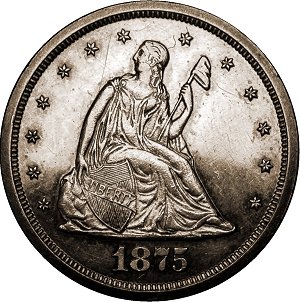
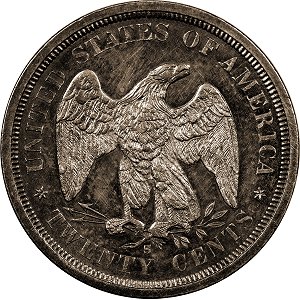
Mintage:
Unknown (no documentation is known)
Scarcity:
Extremely rare with perhaps 7-9 known, with most examples impaired in some wayway
Introduction
To commemorate the first striking of the new denomination, it is believed that a few proofs were struck as presentation pieces in the locale where the so-called “demand” for this coin was greatest.
There is no record of how many were actually coined. Walter Breen listed a mintage of 12, but that is little more than speculation on his part based on the number of pieces known to him. With about
7-9 known, a mintage of 10-15 seems reasonable, and thus the claim of 12 seems in the right ballpark.
Because the branch mints were not normally in the business of making proof coins and all dies were made at the Philadelphia mint and shipped to the branch mints, the dies on hand for these presentation
pieces were nothing special. In the case of the 1875-S twenty-cent branch mint proof coins, the dies used had some definite die markers which appear on the coins. These markers help make the
identification of the pair of dies used to strike the proof coins very straightforward.
To complicate matters, not all of the proof coins have an identical appearance. Although speculative, the dies probably received some additional polishing or preparation before the coins were struck.
In addition, the planchets used were either polished or prepared in some way that would enhance their appearance once struck. It’s likely that as the coins were struck, the dies began to show a
small amount of surface as a result. Subsequent coins struck would appear progressively less like proof coins and more like circulation strikes. Based on the known examples, it appears that only
the first few coins have the appearance of a traditional proof coin and the others appear to be more like a specimen strike; still distinctly different from a circulation strike but not a proof coin.
The dies used to strike the branch mint proofs were later used to produce coins for circulation. Therefore, the diagnostics of the dies are not sufficient alone to determine that a coin is a proof.
The coin must also have the appearance of a proof in order to be considered a proof. For example, the coins must be very well struck, have highly reflective surfaces, clearly separated denticles, and
possess square rims. Several numismatic specialty references are available to assist a collector in determining if a coin may be a proof issue.
The following description will highlight both the diagnostics of the proof dies, along with other evidence which must be present on a coin to be even considered a possible branch mint proof or a specimen strike.
The Obverse
There are two principal diagnostics for the obverse die used to make the proof 1875-S coins.
A small triangular die chip or gouge is present on the left side of the pole, just below Liberty’s hand. This is the most easily visible diagnostic.
There is a series of horizontal die file marks or heavy die polish within the vertical stripes of the shield, below the ribbon with LIBERTY on it. This set of marks will only be visible on high-grade pieces, as the shield is the high point on the obverse, and it is subject to immediate wear.
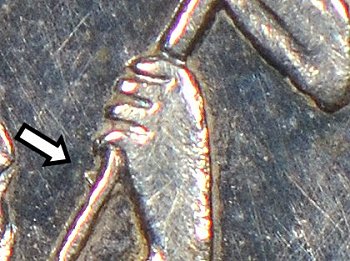 Die chip or gouge below hand |
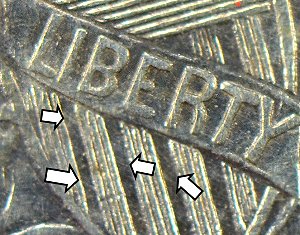 Horizontal die file or polish marks |
The Reverse
There are several diagnostics for the reverse die, and the following are the easiest characteristics to see.
A diagonal die line in the protected area enclosed by the arrow shaft, branch, and claws.
The TS in CENTS is weak and there are two die defects due to excessive die polishing before striking the proof coins. The upper left serif of the T and the lower left serif of the S are separated from the rest of their respective letters. The die lapping also weakened the nearby denticles.
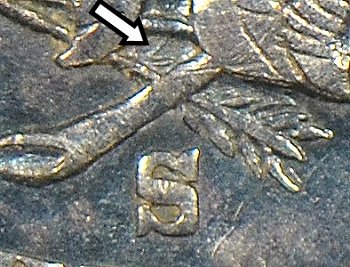 Diagonal die line |
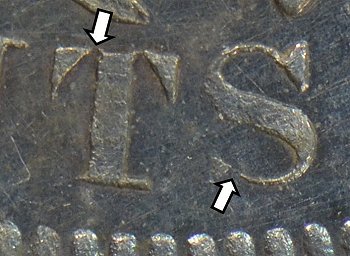 Separated serifs in "TS" |
|
|
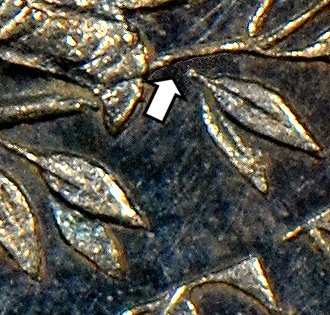 Disconnected leaves |
|
Other general diagnostics
All 1875-S Branch Mint Proofs will have...
